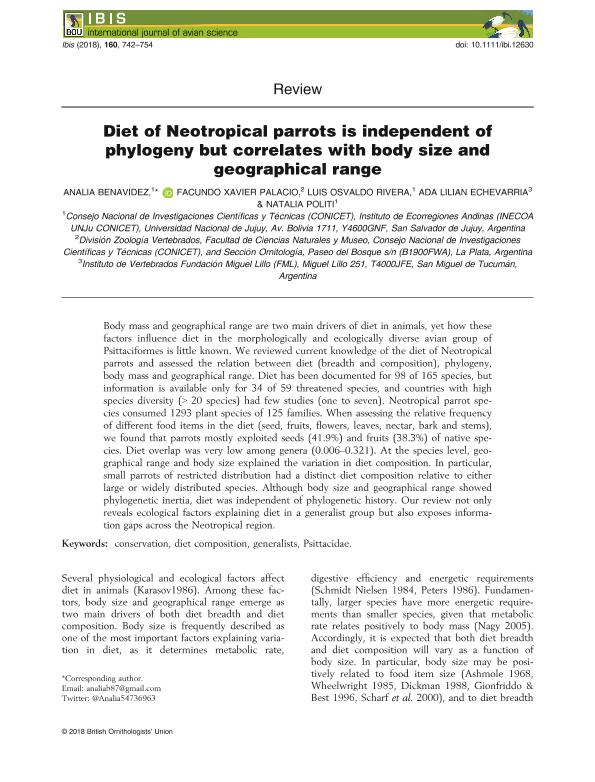Artículo
Diet of Neotropical parrots is independent of phylogeny but correlates with body size and geographical range
Benavídez, Analía ; Palacio, Facundo Xavier
; Palacio, Facundo Xavier ; Rivera, Luis Osvaldo
; Rivera, Luis Osvaldo ; Echevarria, Ada Lilian; Politi, Natalia
; Echevarria, Ada Lilian; Politi, Natalia
 ; Palacio, Facundo Xavier
; Palacio, Facundo Xavier ; Rivera, Luis Osvaldo
; Rivera, Luis Osvaldo ; Echevarria, Ada Lilian; Politi, Natalia
; Echevarria, Ada Lilian; Politi, Natalia
Fecha de publicación:
10/2018
Editorial:
Wiley Blackwell Publishing, Inc
Revista:
Ibis
ISSN:
0019-1019
Idioma:
Inglés
Tipo de recurso:
Artículo publicado
Clasificación temática:
Resumen
Body mass and geographical range are two main drivers of diet in animals, yet how these factors influence diet in the morphologically and ecologically diverse avian group of Psittaciformes is little known. We reviewed current knowledge of the diet of Neotropical parrots and assessed the relation between diet (breadth and composition), phylogeny, body mass and geographical range. Diet has been documented for 98 of 165 species, but information is available only for 34 of 59 threatened species, and countries with high species diversity (> 20 species) had few studies (one to seven). Neotropical parrot species consumed 1293 plant species of 125 families. When assessing the relative frequency of different food items in the diet (seed, fruits, flowers, leaves, nectar, bark and stems), we found that parrots mostly exploited seeds (41.9%) and fruits (38.3%) of native species. Diet overlap was very low among genera (0.006–0.321). At the species level, geographical range and body size explained the variation in diet composition. In particular, small parrots of restricted distribution had a distinct diet composition relative to either large or widely distributed species. Although body size and geographical range showed phylogenetic inertia, diet was independent of phylogenetic history. Our review not only reveals ecological factors explaining diet in a generalist group but also exposes information gaps across the Neotropical region.
Palabras clave:
CONSERVATION
,
DIET COMPOSITION
,
GENERALISTS
,
PSITTACIDAE
Archivos asociados
Licencia
Identificadores
Colecciones
Articulos(INECOA)
Articulos de INSTITUTO DE ECORREGIONES ANDINAS
Articulos de INSTITUTO DE ECORREGIONES ANDINAS
Citación
Benavídez, Analía; Palacio, Facundo Xavier; Rivera, Luis Osvaldo; Echevarria, Ada Lilian; Politi, Natalia; Diet of Neotropical parrots is independent of phylogeny but correlates with body size and geographical range; Wiley Blackwell Publishing, Inc; Ibis; 160; 4; 10-2018; 742-754
Compartir
Altmétricas



